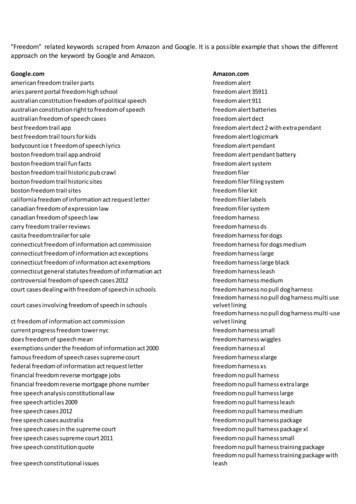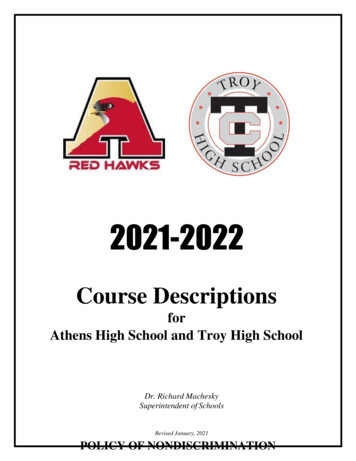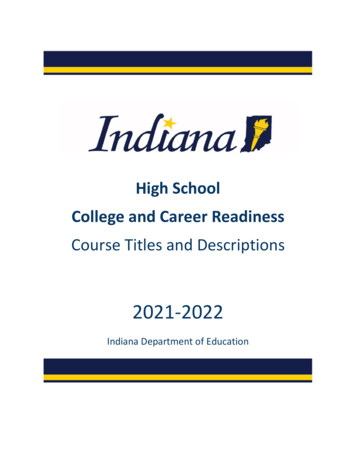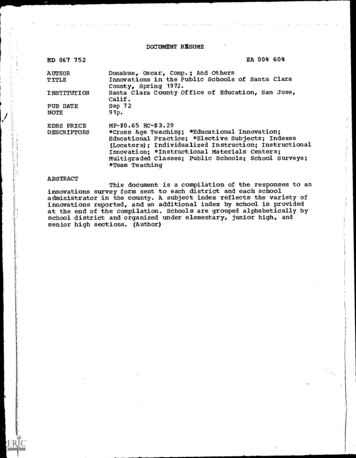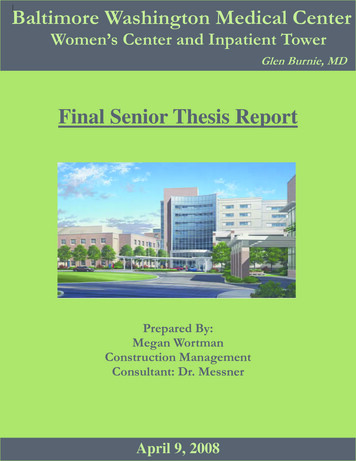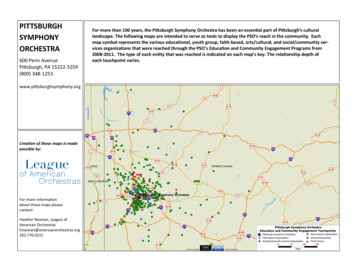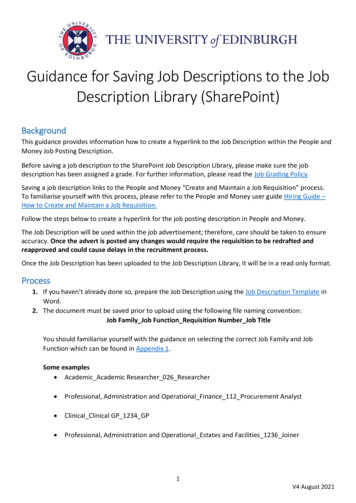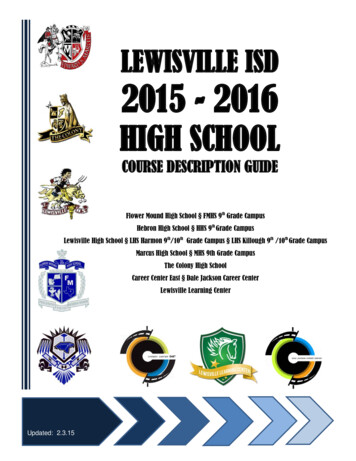
Transcription
LEWISVILLE ISD2015 - 2016HIGH SCHOOLCOURSE DESCRIPTION GUIDEFlower Mound High School § FMHS 9th Grade CampusHebron High School § HHS 9th Grade CampusLewisville High School § LHS Harmon 9th/10th Grade Campus § LHS Killough 9th /10th Grade CampusMarcus High School § MHS 9th Grade CampusThe Colony High SchoolCareer Center East § Dale Jackson Career CenterLewisville Learning CenterUpdated: 2.3.15
It is the policy of Lewisville I.S.D. not to discriminate on the basis of race, color,national origin, sex or handicap in its vocational programs, services or activities asrequired by Title VI of the Civil Rights Act of 1964, as amended; Title IX of theEducation Amendments of 1972; and Section 504 of the Rehabilitation Act of 1973, asamended.It is the policy of Lewisville I.S.D. not to discriminate on the basis of race, color,national origin, sex, handicap, or age in its employment practices as required by TitleVI of the Civil Rights Act of 1964, as amended; Title IX of the Education Amendmentsof 1972; the Age Discrimination Act of 1975, as amended; and Section 504 of theRehabilitation Act of 1973, as amended.Lewisville, I.S.D. will take steps to assure that lack of English language skills will notbe a barrier to admission and participation in all educational and vocational programs.For information about your rights or grievance procedures, contact the Title IXCoordinator, Dr. Kevin Rogers at 1565 West Main St., Lewisville, Texas 75067, 972350-4750 and/or the Section 504 Coordinator, Dr. Paula Walker at 136 West PurnellSt., Lewisville, TX 75057, 469-713-5203.2015 – 2016 HIGH SCHOOL COURSE DESCRIPTION GUIDE (CDG)Page 2
TABLE OF CONTENTSINTRODUCTION . 6GENERAL REQUIREMENTS . 7LISD GRADUATION PLAN OVERVIEW . 8TOWARD EXCELLENCE, ACCESS, & SUCCESS (TEXAS) GRANT PROGRAM . 9TOP TEN PERCENT RULE AND AUTOMATIC ADMISSIONS . 10LISD GRADUATION REQUIREMENTS 2015 – 2016 . 11STUDENTS ENTERING HIGH SCHOOL PRIOR TO 2014-2015 . 11RECOMMENDED HIGH SCHOOL PROGRAM . 11MINIMUM HIGH SCHOOL PROGRAM . 11DISTINGUISHED ACHIEVEMENT PROGRAM . 12RHSP AND DAP OPTIONS FOR FOURTH MATH AND SCIENCE. 13STUDENTS ENTERING HIGH SCHOOL 2014-2015 AND AFTER . 15FOUNDATION HIGH SCHOOL PLAN CORE COURSE OPTIONS . 16FHSP ENDORSEMENTS . 17BENEFITS OF GRADUATING WITH AN ENDORSEMENT . 17FHSP PERFORMANCE ACKNOWLEDGEMENTS. . 17FHSP DISTINGUISHED LEVEL OF ACHIEVEMENT . 18BENEFITS OF THE DISTINGUISHED LEVEL OF ACHIEVEMENT . 18SELECTING AN ENDORSEMENT . 19CORE COURSE REQUIREMENTS BY ENDORSEMENT . 20ADDITIONAL INFORMATION . 22STATE ASSESSMENTS AND GRADUATION REQUIREMENTS . 22GRADE POINT AND RANKING CALCULATION 2015 - 2016 . 23TRANSFER GRADES . 24CREDIT ACCRUAL AND CLASSIFICATION . 24DETERMINING CREDIT FOR FULL-TERM COURSES . 24STUDENT CLASSIFICATION . 25HIGH SCHOOL COURSES TAKEN AT MIDDLE SCHOOL LEVEL. 25ALTERNATIVE METHODS OF CREDIT ACCRUAL. 25LISD PROGRAMS . 28ADVANCED PLACEMENT PROGRAM . 28ADVANCEMENT VIA INDIVIDUAL DETERMINATION (AVID) . 282015 – 2016 HIGH SCHOOL COURSE DESCRIPTION GUIDE (CDG)Page 3
GIFTED / TALENTED SERVICES . 29CORE COURSE LISTINGS . 31ENGLISH – LANGUAGE ARTS . 31MATHEMATICS . 37SCIENCE . 42SOCIAL STUDIES . 49LANGUAGES OTHER THAN ENGLISH/WORLD LANGUAGES . 58ENRICHMENT COURSES . 66ACADEMIC PREPARATION. 66ACADEMIC DECATHLON . 66AP SEMINAR . 66PSAT/SAT/ACT/AP PREPARATION/READING . 67ACADEMIC STUDIES/STUDY SKILLS/STAAR REVIEW . 68ATHLETICS . 72CAREER & TECHNICAL PROGRAMS & ACHIEVETEXAS. 74CAREER CENTER COURSES BY CAMPUS . 77AGRICULTURAL FOOD AND NATURAL RESOURCES . 78ARCHITECTURE AND CONSTRUCTION. 81ARTS, AUDIO VISUAL TECHNOLOGY & COMMUNICATION . 84BUSINESS MANAGEMENT AND ADMINISTRATION . 90EDUCATION AND TRAINING . 93FINANCE. 94HEALTH SCIENCE . 95HOSPITALITY AND TOURISM . 97HUMAN SERVICES . 99INFORMATION TECHNOLOGY. 101LAW, PUBLIC SAFETY, CORRECTIONS, AND SECURITY . 103MANUFACTURING . 105MARKETING . 106SCIENCE, TECHNOLOGY, ENGINEERING, MATH (STEM) . 108TRANSPORTATION, DISTRIBUTION & LOGISTICS. 110TECHNOLOGY APPLICATIONS . 112PRACTICUM/CAREER PREP IN EDUCATION PROGRAMS . 115FINE ARTS . 1172015 – 2016 HIGH SCHOOL COURSE DESCRIPTION GUIDE (CDG)Page 4
ART . 117BAND/ORCHESTRA . 122CHOIR. 126DANCE . 128THEATRE ARTS . 129HEALTH / PHYSICAL EDUCATION . 132JOURNALISM . 135JUNIOR ROTC . 138NAVY JROTC (Naval Science) . 138AIR FORCE JROTC (Aerospace Science) . 140ARMY JROTC (Military Science) . 144SPECIAL EDUCATION COURSES . 146COURSE CODES . 147SPEECH AND DEBATE. 150INDEX OF COURSES . 152APPENDIX . 160ACRONYMS AND ABBREVIATIONS (AAA) . 160GRADUATION PLAN COMPARISON SIDE-BY-SIDE . 161FOUR YEAR PLAN SAMPLES . 162DISTINGUISHED ACHIEVEMENT PROGRAM . 162GRADE . 162RECOMMENDED HIGH SCHOOL PROGRAM . 163GRADE . 163FOUNDATION PROGRAM . 164Arts & Humanities Endorsement - Non-CTE Pathway. 164Business & Industry - CTE Pathway . 165Business & Industry –Non-CTE Pathway . 166Multidisciplinary Endorsement –CTE Pathway . 167Multidisciplinary Endorsement – Non-CTE Pathway . 168Public Services Endorsement – CTE Pathway . 169Public Services Endorsement – Non-CTE Pathway . 170Science, Technology, Engineering & Math - CTE Pathway . 171Science, Technology, Engineering & Math – Non-CTE Pathway . 1722015 – 2016 HIGH SCHOOL COURSE DESCRIPTION GUIDE (CDG)Page 5
INTRODUCTIONPlanning a four-year high school program is a serious undertaking. Although many of yourcourses will be determined by the graduation plan you select, you will still have many otherchoices to make during your years of school. The courses you select will be guided largely byyour plans for the future. Will you continue your education in college or in a trade or technicalschool? Do you want to learn a career skill in order to enter the full-time work forceimmediately after school? Are you interested in a technical field? Are you thinking of enteringa profession that requires many years of specialized education?The answers to these questions are extremely important for making decisions about yourcourse selections for all four years in high school. These answers should also be guided byyour interests and abilities. Some students are sure of their future plans; others are stilldeciding. It is also common for young people to change their minds about which career tochoose. For this reason, it is important for you to plan as challenging a program as youcan. If your career plans should change, then it will not be as difficult to move intoanother program. While it may sometimes seem tempting to schedule a less demandingcombination of courses, choosing courses that meet your needs or interests is the best wayto prepare for your future.LISD offers you many ways to prepare for a productive adult life—to increase thelikelihood that you will realize your future goals. The district’s high schools and careercenters provide a wide range of programs that prepare students for post-high schoolexperiences: college, business school, technical school, military service, fine artsparticipation, full-time employment, and other areas. The programs offered allow a student tochoose the high school program best for him/her, whether that program is the traditionalcollege preparatory, tech-prep, or career preparatory program. Outlined on the followingpages are the graduation requirements for each of the state's possible graduation programs(minimum, recommended high school, and distinguished achievement programs).Immediately following the presentation of possible graduation plans are descriptions of allcourses offered, with accompanying information about prerequisites and grade levelplacement. We strongly urge you to give the attention to planning for high school that itdeserves. By planning wisely, you can create the future that is most appropriate foryou.2015 – 2016 HIGH SCHOOL COURSE DESCRIPTION GUIDE (CDG)Page 6
GENERAL REQUIREMENTSGENERAL INFORMATION 2014-2015Lewisville ISD high schools operate on the accelerated block schedule. Because this type of schedule requiresa different way of arranging the curriculum, students will find different terminology in the course descriptions.The following information will be helpful in understanding accelerated block and making choices about courses.҉Courses are listed as either .5, 1, 1.5, 2, or 3 credits.҉On the accelerated block schedule, 1 credit 18 weeks. On a traditional semester schedule, studentsearn 1 credit after one full year, covering the same amount of material.҉On the accelerated block, during one full year (two terms), a student could be enrolled in as many as 8different blocks of courses (4 in the fall term and 4 in the spring term) with the potential of earning amaximum of 8 credits.҉On the accelerated block schedule, .5 credit 9 weeks 1 quarter. A twenty-seven week course wouldearn 1.5 credits. There are 4 quarters, or 36 weeks in a school year.҉The accelerated block provides for 90-minute class periods. Students are scheduled into four periodsper day, and each class meets every day. Exceptions to this must be approved by campusadministration.҉Each high school may offer selected courses for 18 weeks for .5 credit. These courses will meet for 45minutes per day, with few exceptions. This will be done either during the school day or as a zero hourbefore and/or after school. Check with your counselor for a list of the courses being offered at yourschool.҉Some courses are offered for local credit only and do not count toward state credits needed forgraduation.҉Grade reports are monitored on a three week basis through progress reports, and report cards aredistributed at the end of each nine weeks (quarter).҉UIL eligibility follows a schedule separate and apart from quarter (9 weeks) and semester grading cyclesand is not included in this guide.҉Course “Recommendations” are listed to help ensure a greater measure of success for the student andshould therefore be completed. A student may, however, enroll in a class without taking suggestedcourse recommendations.҉Course “Prerequisites” must be successfully completed before a student is allowed to enroll in a course.҉Credit for courses may be received through credit by exam. For courses without prior instruction, amastery level of 80% is required for credit. For courses where the required amount of prior instructionhas been certified, a mastery level of 70% is required for credit to be awarded. A schedule for testingdates can be obtained from the campus counselor.҉State law/board policy supersedes information in this book.҉Students may graduate early by completing all graduation requirements. The desire to graduate earlywill not subject the student to special consideration in scheduling.҉A student’s graduation plan is determined by the year that the student enters the 9 grade unless achange is mandated by law.҉It is the parent’s responsibility to insure compliance with the requirements for the NCAA Eligibility Centerfor college athletics.th2015 – 2016 HIGH SCHOOL COURSE DESCRIPTION GUIDE (CDG)Page 7
LISD GRADUATION PLAN OVERVIEWSTUDENTS ENTERING HIGH SCHOOL PRIOR TO 2014-2015.There are two basic options available to meet LISD graduation requirements. Those two basic plansare the MINIMUM HIGH SCHOOL PROGRAM (MHSP) and the RECOMMENDED PROGRAM(RHSP). The DISTINGUISHED ACHIEVEMENT PROGRAM (DAP) goes beyond the RHSP. Itrequires advanced schoolwork that reflects college- or professional-level skills. To earn this honor,you must complete three credits in the same foreign language, complete specific courses in corecontent areas, and complete a combination of four of the advanced "measures".Each of these plans requires 26 credits to graduate. The RHSP should be considered for moststudents and for all students who plan to enter college. The RHSP or DAP is required unless waivedby a special committee. The basic requirements for each program, including the DAP, are outlined onthe following pages.This group of students are also permitted to graduate on the Foundation High School Programas outlined below. Lewisville ISD encourages all students to remain on the current RHSP or DAP.Graduating seniors should clarify with their college of choice that moving to a differentgraduation plan will not adversely impact their admission status. For a comparison of the currentgraduation plans with the new Foundation Plan See Graduation Plan Comparison Side-by-Side in theAppendix.STUDENTS ENTERING HIGH SCHOOL 2014-15 AND BEYOND.HB5, passed by the Texas Legislature this spring, made substantial changes to the state's graduationrequirements, moving from the current "4x4" graduation plans to a 22-credit Foundation High SchoolProgram (FHSP) that allows students to earn endorsements in specific areas of study by completingfour additional credits and performance acknowledgements. Students entering high school in the fallof 2014-15 will be required to meet the requirements of the foundation high school program to receivea high school diploma.The endorsement areas are Science, Technology, Engineering and Mathematics (STEM); Businessand Industry; Public Services; Arts and Humanities; and Multidisciplinary Studies. LISD offers coursesto meet endorsements in all areas. There are specific course requirements in the foundationcurriculum based on the endorsement selected. Please see the comparison of core courserequirements by endorsement.A student may elect to graduate without an endorsement under the high school foundation plan afterthe student's sophomore year if the student and the student's parent or guardian are advised by theschool counselor of the benefits of graduating with one or more endorsement; and the student'sparent or guardian files written permission with the high school allowing the student to graduatewithout an endorsement.2015 – 2016 HIGH SCHOOL COURSE DESCRIPTION GUIDE (CDG)Page 8
TOWARD EXCELLENCE, ACCESS, & SUCCESS (TEXAS) GRANT PROGRAMProgram PurposeThe Texas Legislature established the TEXAS (Toward EXcellence, Access and Success) Grant to make surethat well-prepared high school graduates with financial need could go to college.Who can apply? Students who.҉҉҉҉҉҉҉҉҉҉Are Texas residentsHave not been convicted of a felony or crime involving a controlled substanceShow financial needRegister for the Selective Service or are exempt from this requirementComplete the Recommended High School Program, Distinguished Achievement Program OR theFoundation High School Program in high schoolStudents graduating with the Foundation High School Program MAY have additional eligibility criteriato qualify for the TEXAS Grant. Information will be updated as received from the SBOE.Enroll in a non-profit public college or university in Texas within 16 months of graduation from a public oraccredited private high school in Texas andHave accumulated no more than 30 semester credit hours, excluding those earned for dual orconcurrent courses or awarded for credit by examination (Advanced Placement or College LevelPlacement)Students entering the program from high school who continue in college and who meet programacademic standards can receive awards for up to 150 semester credit hours, until they receive abachelor's degree, or for five years if enrolled in a 4-year degree plan or six years if enrolled in a 5-yeardegree plan, whichever comes firstHave an Estimated Family Contribution less than or equal to 4000The academic requirements for continuing in the program are:҉ At the end of the first year, the student entering the program from high school must meet the school'sSatisfactory Academic Progress (SAP) requirements҉ At the end of the second year in the program or later years, all students must complete at least 75percent of the hours attempted in the prior academic year, have an overall college grade point average(GPA) of at least 2.5 on a 4.0 scale and complete at least 24 semester credit hours per yearWhere may awards be used?A TEXAS Grant may be used to attend any public institution of higher education in Texas.How much can be awarded?The award amount (including state and institutional funds) is equal to the student's tuition and required fees.For 2013-2014, the state amount was approximately:҉ 7,400 per year for public universities and state college students҉ 2,400 per year for public community college students҉ 4,400 per year for public technical college studentsHow can you apply?You apply for the TEXAS Grant when you complete and submit the Free Application for Federal Student Aid(FAFSA) or other application as required by your college's financial aid office. Funding is limited, so you need tosubmit your application as soon as possible after January 1 of your senior year. The financial aid office at eachcollege and university will determine if the TEXAS Grant is part of the aid package that is offered to you.2015 – 2016 HIGH SCHOOL COURSE DESCRIPTION GUIDE (CDG)Page 9
TOP TEN PERCENT RULE AND AUTOMATIC ADMISSIONSTop students are eligible for automatic admission to any public university in Texas under admissionspolicies. Under TEC 51.803, students who are in the top 10 percent of their graduating class areeligible for automatic admission to any public university in Texas.To be eligible for automatic admission, a student must:҉ Graduate in the top 10 percent of his or her class at a public or private high school in Texas,OR҉ Graduate in the top 10 percent of his or her class from a high school operated by the U.S.Department of Defense and be a Texas resident or eligible to pay resident tuition;҉ Graduate on the Recommended High School Program (RHSP), Distinguished AchievementProgram (DAP), or Foundation High School Program (FHSP);҉ Earn a Distinguished Level of Achievement (DLA) if graduating on the FHSP;҉ Satisfy the College Readiness Benchmarks on SAT or ACT assessments.o SAT – 1500 out of 2400 (critical reading, math and writing)o ACT – 18 English, 21 Reading, 22 Math, 24 Science҉ Enroll in college no more than two years after graduating from high school; and҉ Submit an application to a Texas public university for admission before the institution'sapplication deadline with all required documentation (check with the university regardingspecific deadlines).Students admitted through this route are still required to provide SAT or ACT scores, although thesescores are not used for admissions purposes. Check with the college admissions office regardingtesting requirements.After a student is admitted, the university may review the student's high school records to determine ifthe student is prepared for college-level work. A student who needs additional preparation may berequired to take a developmental, enrichment, or orientation course during the semester prior to thefirst semester of college.Admission to a university does not guarantee acceptance into a particular college of study ordepartment. Remember that you may not be admitted even if you are eligible if you do not meet theadmission deadline.Modifications to Texas’ Automatic Admission Law – SB 175, passed by the 81st Legislature in thespring of 2009, modifies TEC 51.802 for The University of Texas at Austin. Under the new law, theUniversity is to automatically admit enough students to fill 75% of available Texas resident spaces.By September 15th of each year, the University will notify Texas school officials of the class rank thatcurrent high school juniors need to attain by the end of their junior year in order to be automaticallyadmitted two years out of high school. SB 175 went into effect with the 2011 summer/fall class andwill remain in effect at least through the 2015-2016 academic year. For additional information, seeUT website (www.utexas.edu).2015 – 2016 HIGH SCHOOL COURSE DESCRIPTION GUIDE (CDG)Page 10
LISD GRADUATION REQUIREMENTS 2015 – 2016STUDENTS ENTERING HIGH SCHOOL PRIOR TO 2014-2015RHSP AND MHSP GRADUATION REQUIREMENTSRECOMMENDED HIGH SCHOOL PROGRAMMINIMUM HIGH SCHOOL PROGRAMTHIS PROGRAM REQUIRES ADMINISTRATIVE APPROVALEnglish I, II, III, IV (4 credits)English I, II, III, IV (4 credits)Math (4 credits): Algebra IGeometryAlgebra IIOther Math creditMath (3 credits): Algebra IGeometryOther Math creditScience (4 credits): Biological and Physical SciencesOne credit in each: Biology, Chemistry Physics Other Science CoursesScience (3 credits):Social Studies (4 credits):World GeographyWorld History (1)U.S. History (1)U.S. Government (.5), Economics (.5)Social Studies (4 credits):World GeographyWorld History (1)U.S. History (1)U.S. Government (.5), Economics (.5)1 Biology courseIntegrated Physics & Chemistry (one credit in chemistryand one credit in physics can substitute for IPC)Other Science Courses1Physical Education or Substitution (1 credit)Physical Education or Substitution (1 credit)Speech (.5 credit):Communication Applications ORProfessional Communications (CTE)Language Other Than English (2 credits)Must be in the same languageSpeech (.5 credit):Communication Applications , ORProfessional Communications (CTE)22Fine Arts (1 credit)Electives (5.5 credits)Fine Arts (1 credit)Electives (9.5 credits) – (4) may be local26 CREDITS TOTAL26 CREDITS TOTALNOTE: The DISTINGUISHED ACHIEVEMENT PROGRAM (DAP) goes beyond the RHSP. It requires advanced schoolwork that reflectscollege- or professional-level skills. Students who graduate with the RHSP or DAP are eligible for the TEXAS Grant I Program (H.B. 713) iffinancial need is determined.1 PE Credit/Substitution - 4 credits of PE or PE substitution may be used toward state graduation requirements. The following courses maybe taken as a PE substitution: Cheerleading (Varsity, Jr. Varsity, Freshman); Drill Team; Marching Band (1st 9 weeks only); External PE;Athletics; JROTC. Only one state credit allowed per year.2 Fine Arts - credit under the Recommended and Minimum Programs must be earned from the following list of courses: Art I-IV, all AP Art,Orchestra I-IV, Choir I-IV, Dance I, Theatre Arts I-IV, Theatre Production I-IV, Technical Theatre I-IV, Band I-IV, Music Theory.All students must pass State Mandated Assessments in order to graduate. See page 2
choose the high school program best for him/her, whether that program is the traditional college preparatory, techprep, or career preparatory program. Outlined on the following - pages are the graduation requirements for each of the state's possible graduation programs (minimum, recommended high school, and distinguished achievement programs).

